Abstract
The action of nifedipine given first intravenously and then orally was studied in nine patients undergoing investigation for angina pectoris who were already receiving atenolol (100-200 mg/daily) and who had been shown to be fully beta blocked (reduction in maximal heart rate by greater than 25%). Intravenous nifedipine 7.5 micrograms/kg reduced both systolic blood pressure and left ventricular pressure (dP/dt) transiently; both values were significantly lower five and 10 minutes after the infusion of nifedipine but were not significantly different from control values at 20 minutes. There was minimal but pronounced depression of atrioventricular nodal function after giving intravenous nifedipine, though this was detected only when sensitive tests of atrioventricular nodal function were used. These effects were also transient, showing no significant change from control values at 20 minutes. Atrioventricular nodal conduction time and sinus rate were unchanged. Radionuclide angiography of patients taking the oral combination of atenolol and nifedipine for chronic angina showed no change in ejection fraction compared with those taking atenolol alone, but there was a small increase in peak ejection rate. Resting blood pressure and heart rate were unchanged and the PR interval did not lengthen. Peak heart rate and systolic blood pressure showed no alteration on exercise testing when the drugs were combined compared with the response with atenolol alone. Despite the negative inotropic influence when nifedipine was given intravenously, the absence of haemodynamic deterioration when oral nifedipine is combined with atenolol has confirmed that this combination can be used safely in patients with normal left ventricular function. The minimal changes in atrioventricular nodal function cannot be detected on the surface electrocardiogram and are not of clinical importance in patients with normal conduction.
Full text
PDF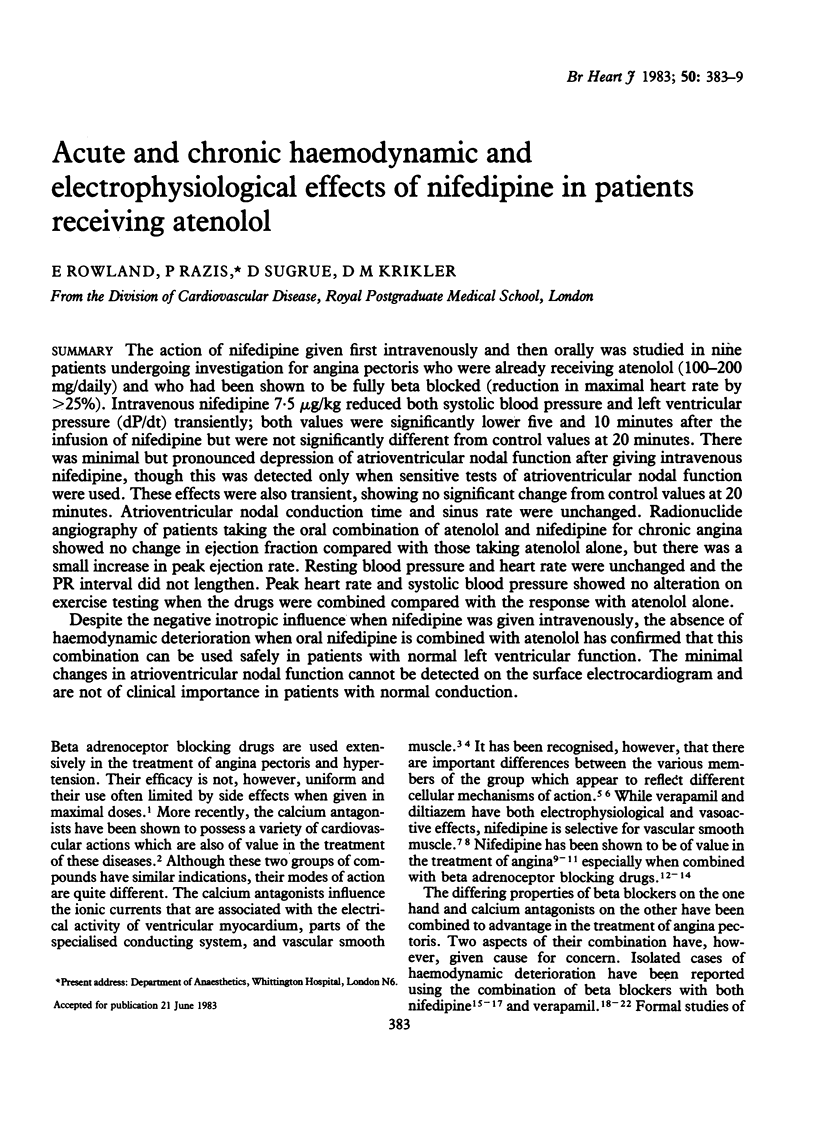
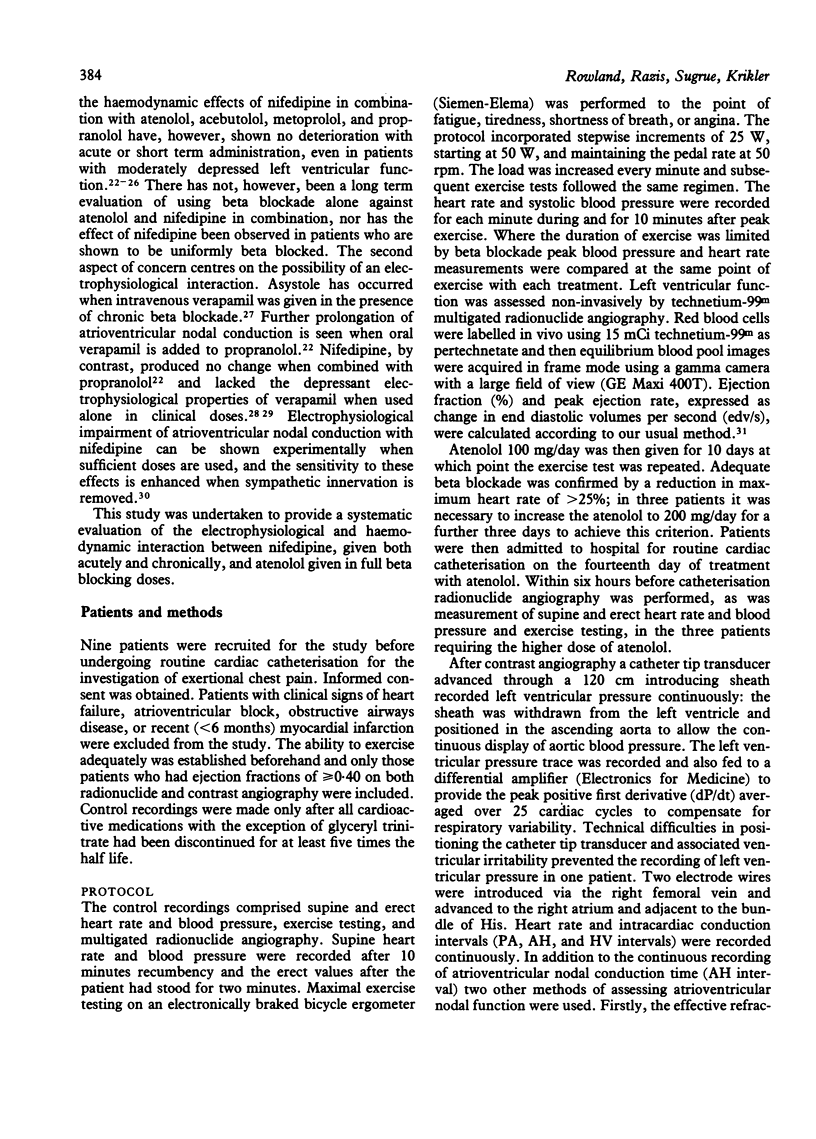
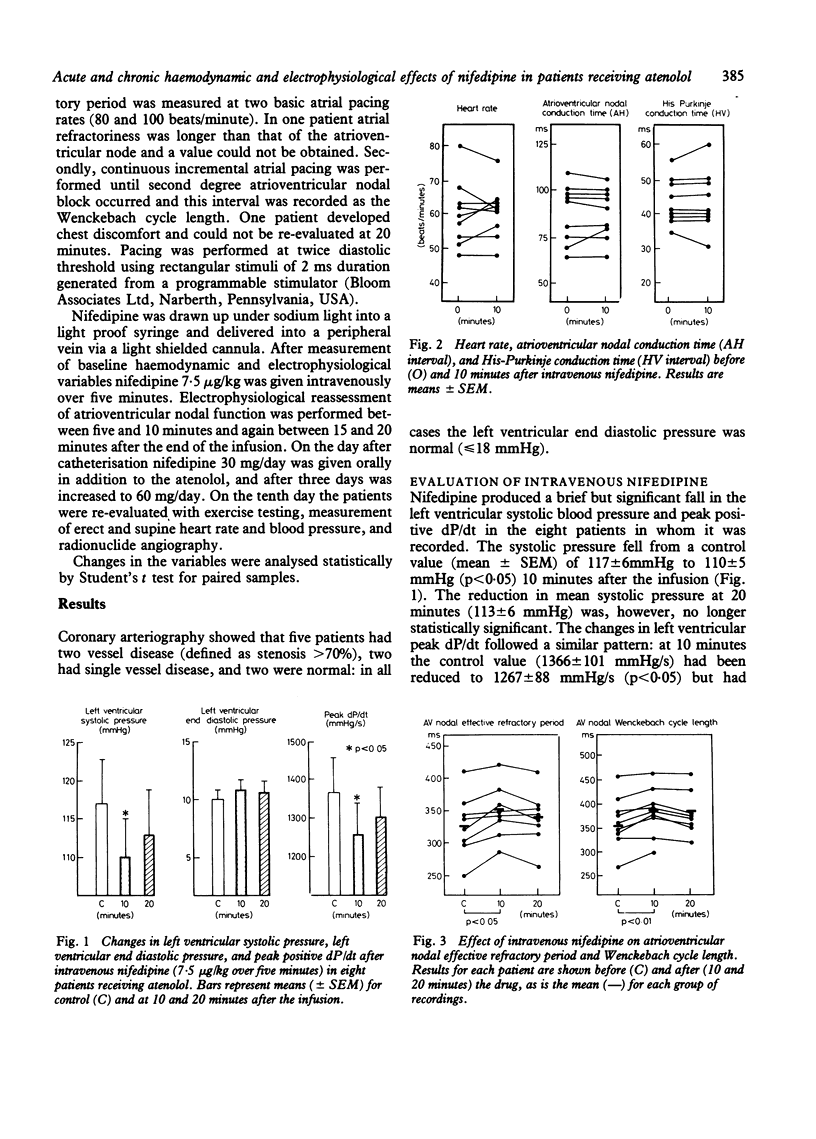
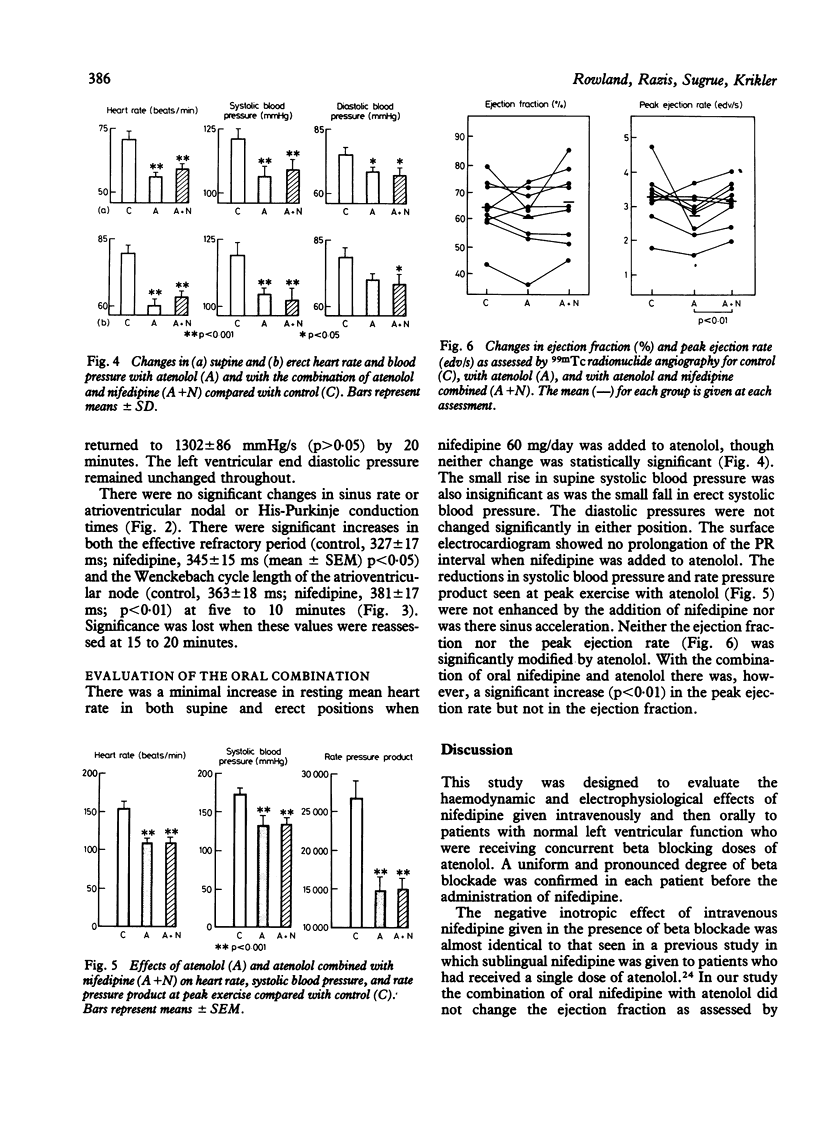
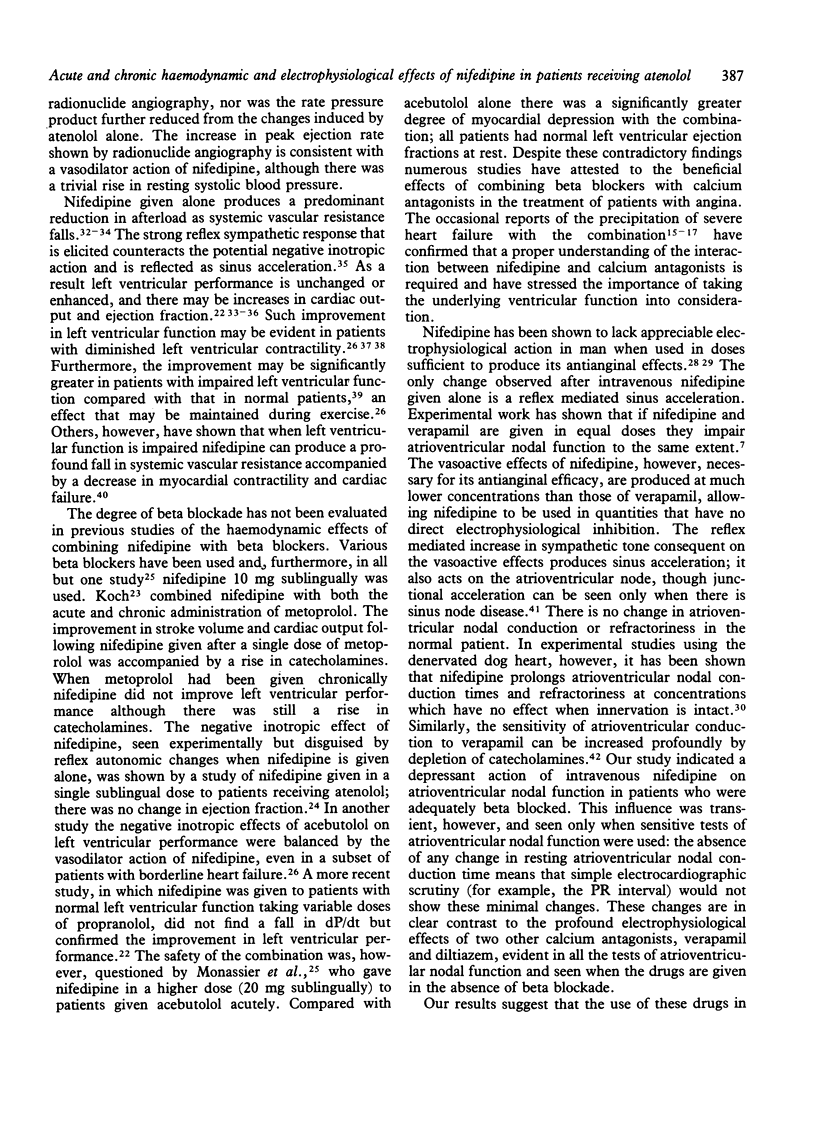
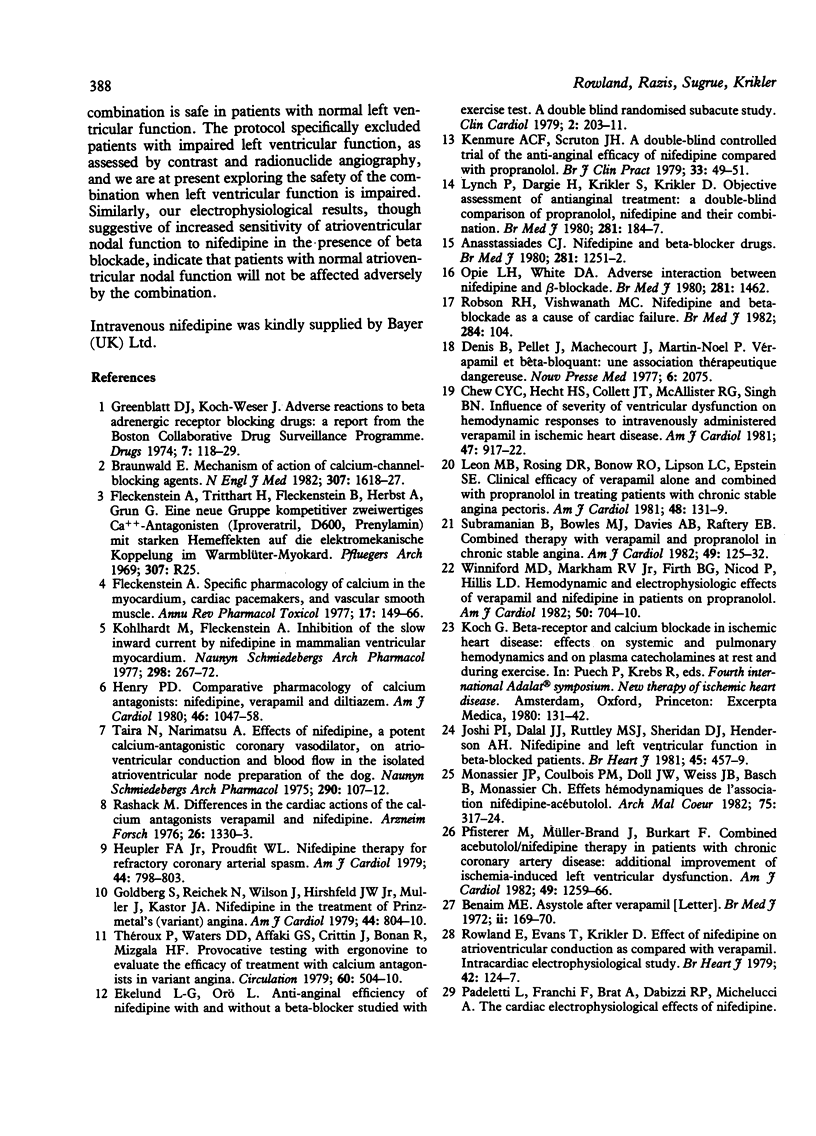
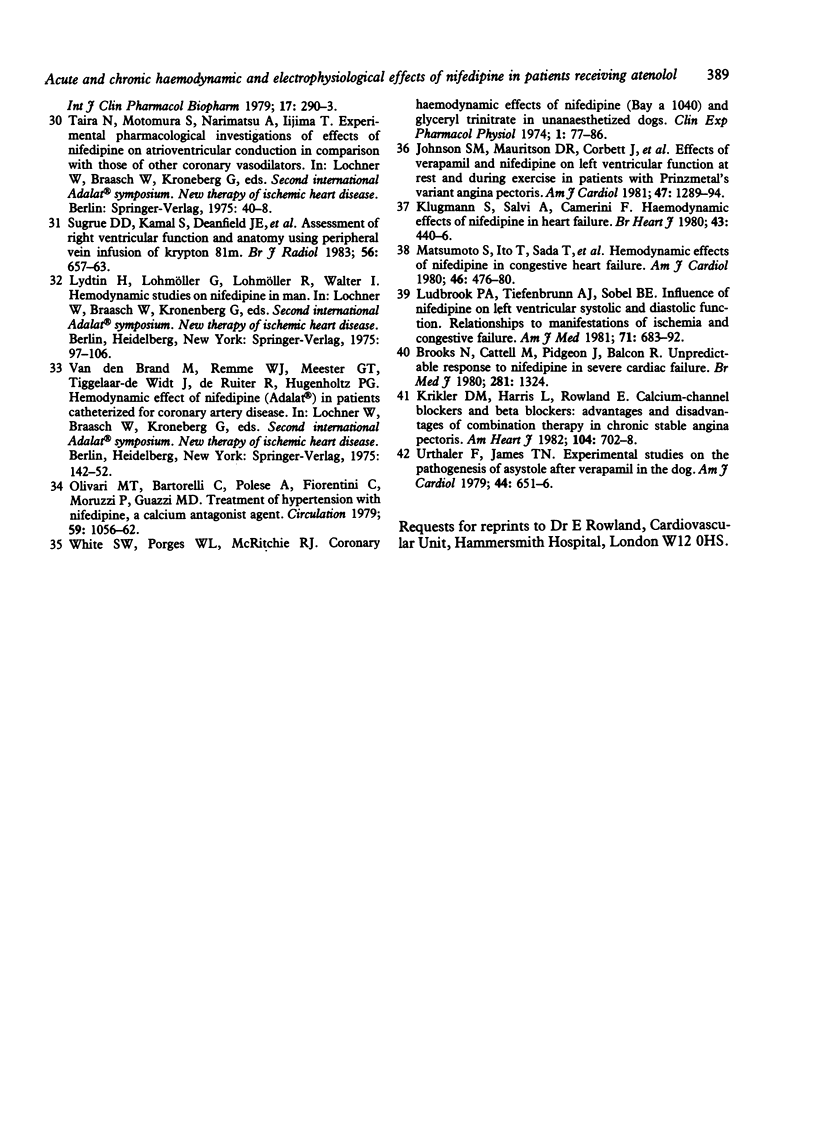
Selected References
These references are in PubMed. This may not be the complete list of references from this article.
- Benaim M. E. Asystole after verapamil. Br Med J. 1972 Apr 15;2(5806):169–170. doi: 10.1136/bmj.2.5806.169-b. [DOI] [PMC free article] [PubMed] [Google Scholar]
- Braunwald E. Mechanism of action of calcium-channel-blocking agents. N Engl J Med. 1982 Dec 23;307(26):1618–1627. doi: 10.1056/NEJM198212233072605. [DOI] [PubMed] [Google Scholar]
- Brooks N., Cattell M., Pidgeon J., Balcon R. Unpredictable response to nifedipine in severe cardiac failure. Br Med J. 1980 Nov 15;281(6251):1324–1324. doi: 10.1136/bmj.281.6251.1324. [DOI] [PMC free article] [PubMed] [Google Scholar]
- Chew C. Y., Hecht H. S., Collett J. T., McAllister R. G., Singh B. N. Influence of severity of ventricular dysfunction on hemodynamic responses to intravenously administered verapamil in ischemic heart disease. Am J Cardiol. 1981 Apr;47(4):917–922. doi: 10.1016/0002-9149(81)90194-6. [DOI] [PubMed] [Google Scholar]
- Denis B., Pellet J., Machecourt J., Martin-Noël P. Vérapamil et bêta-bloquant: une association thérapeutique dangereuse. Nouv Presse Med. 1977 Jun 4;6(23):2075–2075. [PubMed] [Google Scholar]
- Ekelund L. G., Orö L. Antianginal efficiency of nifedipine with and without a beta-blocker, studied with exercise test. A double-blind, randomized subacute study. Clin Cardiol. 1979 Jun;2(3):203–211. doi: 10.1002/clc.4960020306. [DOI] [PubMed] [Google Scholar]
- Fleckenstein A. Specific pharmacology of calcium in myocardium, cardiac pacemakers, and vascular smooth muscle. Annu Rev Pharmacol Toxicol. 1977;17:149–166. doi: 10.1146/annurev.pa.17.040177.001053. [DOI] [PubMed] [Google Scholar]
- Goldberg S., Reichek N., Wilson J., Hirshfeld J. W., Jr, Muller J., Kastor J. A. Nifedipine in the treatment of Prinzmetal's (variant) angina. Am J Cardiol. 1979 Oct 22;44(5):804–810. doi: 10.1016/0002-9149(79)90201-7. [DOI] [PubMed] [Google Scholar]
- Greenblatt D. J., Koch-Weser J. Adverse reactions to beta-adrenergic receptor blocking drugs: a report from the Boston collaborative drug surveillance program. Drugs. 1974;7(1):118–129. doi: 10.2165/00003495-197407010-00008. [DOI] [PubMed] [Google Scholar]
- Henry P. D. Comparative pharmacology of calcium antagonists: nifedipine, verapamil and diltiazem. Am J Cardiol. 1980 Dec 1;46(6):1047–1058. doi: 10.1016/0002-9149(80)90366-5. [DOI] [PubMed] [Google Scholar]
- Heupler F. A., Jr, Proudfit W. L. Nifedipine therapy for refractory coronary arterial spasm. Am J Cardiol. 1979 Oct 22;44(5):798–803. doi: 10.1016/0002-9149(79)90200-5. [DOI] [PubMed] [Google Scholar]
- Johnson S. M., Mauritson D. R., Corbett J., Dehmer G. J., Lewis S. E., Willerson J. T., Hillis L. D. Effect of verapamil and nifedipine on left ventricular function at rest and during exercise in patients with Prinzmetal's variant angina pectoris. Am J Cardiol. 1981 Jun;47(6):1289–1294. doi: 10.1016/0002-9149(81)90261-7. [DOI] [PubMed] [Google Scholar]
- Joshi P. I., Dalal J. J., Ruttley M. S., Sheridan D. J., Henderson A. H. Nifedipine and left ventricular function in beta-blocked patients. Br Heart J. 1981 Apr;45(4):457–459. doi: 10.1136/hrt.45.4.457. [DOI] [PMC free article] [PubMed] [Google Scholar]
- Kenmure A. C., Scruton J. H. A double-blind controlled trial of the anti-anginal efficacy of nifedipine compared with propranolol. Br J Clin Pract. 1979 Feb;33(2):49–51. [PubMed] [Google Scholar]
- Klugmann S., Salvi A., Camerini F. Haemodynamic effects of nifedipine in heart failure. Br Heart J. 1980 Apr;43(4):440–446. doi: 10.1136/hrt.43.4.440. [DOI] [PMC free article] [PubMed] [Google Scholar]
- Kohlhardt M., Fleckenstein A. Inhibition of the slow inward current by nifedipine in mammalian ventricular myocardium. Naunyn Schmiedebergs Arch Pharmacol. 1977 Jul;298(3):267–272. doi: 10.1007/BF00500899. [DOI] [PubMed] [Google Scholar]
- Krikler D. M., Harris L., Rowland E. Calcium-channel blockers and beta blockers: advantages and disadvantages of combination therapy in chronic stable angina pectoris. Am Heart J. 1982 Sep;104(3):702–708. doi: 10.1016/0002-8703(82)90259-9. [DOI] [PubMed] [Google Scholar]
- Leon M. B., Rosing D. R., Bonow R. O., Lipson L. C., Epstein S. E. Clinical efficacy of verapamil alone and combined with propranolol in treating patients with chronic stable angina pectoris. Am J Cardiol. 1981 Jul;48(1):131–139. doi: 10.1016/0002-9149(81)90582-8. [DOI] [PubMed] [Google Scholar]
- Ludbrook P. A., Tiefenbrunn A. J., Sobel B. E. Influence of nifedipine left ventricular systolic and diastolic function. Relationships to manifestations of ischemia and congestive failure. Am J Med. 1981 Oct;71(4):683–692. doi: 10.1016/0002-9343(81)90239-4. [DOI] [PubMed] [Google Scholar]
- Lynch P., Dargie H., Krikler S., Krikler D. Objective assessment of antianginal treatment: a double-blind comparison of propranolol, nifedipine, and their combination. Br Med J. 1980 Jul 19;281(6234):184–187. doi: 10.1136/bmj.281.6234.184. [DOI] [PMC free article] [PubMed] [Google Scholar]
- Matsumoto S., Ito T., Sada T., Takahashi M., Su K. M., Ueda A., Okabe F., Sato M., Sekine I., Ito Y. Hemodynamic effects of nifedipine in congestive heart failure. Am J Cardiol. 1980 Sep;46(3):476–480. doi: 10.1016/0002-9149(80)90018-1. [DOI] [PubMed] [Google Scholar]
- Monassier J. P., Coulbois P. M., Doll J. W., Weiss J. B., Basch B., Monassier C. Effets hémodynamiques de l'association nifédipine-acébutolol. Arch Mal Coeur Vaiss. 1982 Mar;75(3):317–323. [PubMed] [Google Scholar]
- Olivari M. T., Bartorelli C., Polese A., Fiorentini C., Moruzzi P., Guazzi M. D. Treatment of hypertension with nifedipine, a calcium antagonistic agent. Circulation. 1979 May;59(5):1056–1062. doi: 10.1161/01.cir.59.5.1056. [DOI] [PubMed] [Google Scholar]
- Opie L. H., White D. A. Adverse interaction between nifedipine and beta-blockade. Br Med J. 1980 Nov 29;281(6253):1462–1462. doi: 10.1136/bmj.281.6253.1462. [DOI] [PMC free article] [PubMed] [Google Scholar]
- Pfisterer M., Müller-Brand J., Burkart F. Combined acebutolol/nifedipine therapy in patients with chronic coronary artery disease: additional improvement of ischemia-induced left ventricular dysfunction. Am J Cardiol. 1982 Apr 1;49(5):1259–1266. doi: 10.1016/0002-9149(82)90053-4. [DOI] [PubMed] [Google Scholar]
- Raschack M. Differences in the cardiac actions of the calcium antagonists verapamil and nifedipine. Arzneimittelforschung. 1976;26(7):1330–1333. [PubMed] [Google Scholar]
- Robson R. H., Vishwanath M. C. Nifedipine and beta-blockade as a cause of cardiac failure. Br Med J (Clin Res Ed) 1982 Jan 9;284(6309):104–104. doi: 10.1136/bmj.284.6309.104. [DOI] [PMC free article] [PubMed] [Google Scholar]
- Rowland E., Evans T., Krikler D. Effect of nifedipine on atrioventricular conduction as compared with verapamil. Intracardiac electrophysiological study. Br Heart J. 1979 Aug;42(2):124–127. doi: 10.1136/hrt.42.2.124. [DOI] [PMC free article] [PubMed] [Google Scholar]
- Subramanian B., Bowles M. J., Davies A. B., Raftery E. B. Combined therapy with verapamil and propranolol in chronic stable angina. Am J Cardiol. 1982 Jan;49(1):125–132. doi: 10.1016/0002-9149(82)90286-7. [DOI] [PubMed] [Google Scholar]
- Sugrue D. D., Kamal S., Deanfield J. E., McKenna W. J., Myers M. J., Watson I. A., Oakley C. M., Lavender J. P. Assessment of right ventricular function and anatomy using peripheral vein infusion of krypton 81m. Br J Radiol. 1983 Sep;56(669):657–663. doi: 10.1259/0007-1285-56-669-657. [DOI] [PubMed] [Google Scholar]
- Taira N., Narimatsu A. Effects of nifedipine, a potent calcium-antagonistic coronary vasodilator, on atrioventricular conduction and blood flow in the isolated atrioventricular node preparation of the dog. Naunyn Schmiedebergs Arch Pharmacol. 1975;290(1):107–112. doi: 10.1007/BF00499993. [DOI] [PubMed] [Google Scholar]
- Théroux P., Waters D. D., Affaki G. S., Crittin J., Bonan R., Mizgala H. F. Provocative testing with ergonovine to evaluate the efficacy of treatment with calcium antagonists in variant angina. Circulation. 1979 Sep;60(3):504–510. doi: 10.1161/01.cir.60.3.504. [DOI] [PubMed] [Google Scholar]
- Urthaler F., James T. N. Experimental studies on the pathogenesis of asystole after verapamil in the dog. Am J Cardiol. 1979 Oct;44(4):651–656. doi: 10.1016/0002-9149(79)90283-2. [DOI] [PubMed] [Google Scholar]
- White S. W., Porges W. L., McRitchie R. J. Coronary haemodynamic effects of nifedipine (Bay a 1040) and glyceryl trinitrate in unanaesthetized dogs. Clin Exp Pharmacol Physiol. 1974 Jan-Feb;1(1):77–86. doi: 10.1111/j.1440-1681.1974.tb00529.x. [DOI] [PubMed] [Google Scholar]
- Winniford M. D., Markham R. V., Jr, Firth B. G., Nicod P., Hillis L. D. Hemodynamic and electrophysiologic effects of verapamil and nifedipine in patients on propranolol. Am J Cardiol. 1982 Oct;50(4):704–710. doi: 10.1016/0002-9149(82)91222-x. [DOI] [PubMed] [Google Scholar]


